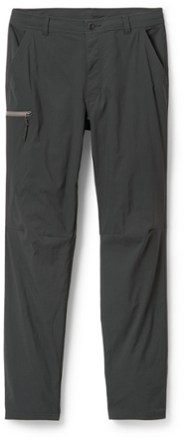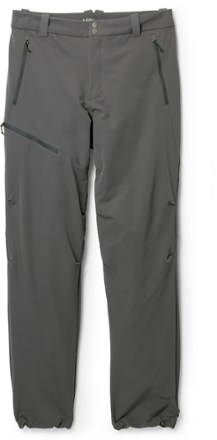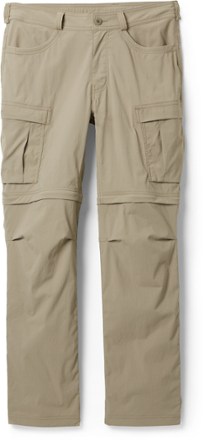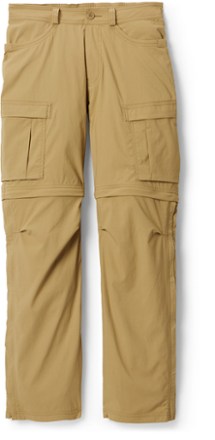The Best Base Layers of 2024: Staff Picks
A solid base layer is part and parcel of staying warm in the backcountry. As the garment closest to your skin, it insulates you from the cold and wicks away sweat—all in the name of helping you regulate your body temperature.
But with all the base layer options available (materials, cuts, styles and weights), finding the best one for you can feel trickier than staying warm on a wet day in the mountains. It’s all dependent on the activity, how hot or cold you run and, well, personal preference. We asked backpackers, skiers, runners, parents and our very own employees to share their favorites available at REI—so the next time you head outside, you can trust your layer to pull its weight.
Multiday backcountry treks call for a layer that can do a few things really well: Wick sweat, resist odor and feel comfortable (read: no bunching) beneath a big pack. For that, our experts reach for the REI Co-op Midweight base layers. The poly half-zip top and bottoms wick away moisture quickly to help keep you both dry and warm outdoors. A hit of spandex in the fabric blend of the women's styles gives them a bit of stretch, though, so they're comfy, and the pants retain their shape longer than some others.
Customer-reviewers rave about the fit, which is tailored without looking or feeling clingy. Importantly, the layer comes in a range of sizes, from petite to 3X for women and up to XXXL with tall sizes for men—all of which are available in stores.
The style transitions well from the backcountry (backpackers love the rolled-forward shoulder seams that resist pack-strap chafing) to city streets to the home office. Plus, the bottoms are cozy enough to wear between adventures—like, say, when you're relaxing at home on the couch. One customer-reviewer writes: "They are super comfortable and are my favorite piece of lounge wear; if I had another $400 to spend, I'd get a full set for every day of the week and live in them when I'm not working."
Though wool is better known for its anti-stink powers, the poly-spandex blend does a great job keeping odors at bay. Bonus: Because synthetic layers are often more affordable than wool, the Midweight is a good option if you're looking to save a few bucks.
Bottoms Women's, Men's
Sustainability attributes These layers were made in a Fair Trade Certified™ factory and contain materials that meet the bluesign® criteria. Some styles contain recycled materials.
Multiday backcountry treks call for a layer that can do a few things really well: Wick sweat, resist odor and feel comfortable (read: no bunching) beneath a big pack. For that, our experts reach for the REI Co-op Midweight base layers. The poly half-zip top and bottoms wick away moisture quickly to help keep you both dry and warm outdoors. A hit of spandex in the fabric blend of the women's styles gives them a bit of stretch, though, so they're comfy, and the pants retain their shape longer than some others.
Customer-reviewers rave about the fit, which is tailored without looking or feeling clingy. Importantly, the layer comes in a range of sizes, from petite to 3X for women and up to XXXL with tall sizes for men—all of which are available in stores.
The style transitions well from the backcountry (backpackers love the rolled-forward shoulder seams that resist pack-strap chafing) to city streets to the home office. Plus, the bottoms are cozy enough to wear between adventures—like, say, when you're relaxing at home on the couch. One customer-reviewer writes: "They are super comfortable and are my favorite piece of lounge wear; if I had another $400 to spend, I'd get a full set for every day of the week and live in them when I'm not working."
Though wool is better known for its anti-stink powers, the poly-spandex blend does a great job keeping odors at bay. Bonus: Because synthetic layers are often more affordable than wool, the Midweight is a good option if you're looking to save a few bucks.
Bottoms Women's, Men's
Sustainability attributes These layers were made in a Fair Trade Certified™ factory and contain materials that meet the bluesign® criteria. Some styles contain recycled materials.
You know that favorite T-shirt that, even after years of use, continues to have a special place in your closet? That's how many users think of their Patagonia Capilene Midweight base layers. Says one customer reviewer of the well-loved layer: "My husband wore his 40-year-old pair of long johns into rags and loved them so much we bought another set." The smooth, stretchy fabric of both the half-zip top and bottoms rests lightly on your skin and traps body heat, making the Capilene Midweight popular among downhill skiers who want barely-there warmth under bulkier layers. And the HeiQ® Fresh antimicrobial treatment helps inhibit growth of odor-causing bacteria on the fabric, which helps keep you smelling fresh for longer.
"The odor control is a plus for long expeditions or a day on the slopes," says one customer reviewer. "They're breathable enough to keep body temps regulated while exerting high energy in snow conditions."
The Capilene base layers work for off-piste adventures, too. "The midweight warmth and half-zip offer a lot of flexibility, and I'll often wear it for more aerobic activities like running or ski touring," says Michelle Flandreau, managing editor at REI Co-op, who has worn hers since 2014. Note: The Capilene Midweight was updated in recent years, and some customer reviewers say the women's fit is slightly snugger, especially around the bust. If you like a looser fit, consider sizing up.
Our staffers also appreciate the matching bottoms. The thick waistband ensures the pants stay put, and they layer well under ski socks and boots. The only caveat: "I do have to be intentional with making sure everything is lined up appropriately," Flandreau says. "If I don't, sometimes the seams will start to rub or dig in by the end of a long day."
Bottoms Women's, Men's
Sustainability attributes Made using Fair Trade Certified™ sewing, materials that meet bluesign® criteria and recycled materials.
You know that favorite T-shirt that, even after years of use, continues to have a special place in your closet? That's how many users think of their Patagonia Capilene Midweight base layers. Says one customer reviewer of the well-loved layer: "My husband wore his 40-year-old pair of long johns into rags and loved them so much we bought another set." The smooth, stretchy fabric of both the half-zip top and bottoms rests lightly on your skin and traps body heat, making the Capilene Midweight popular among downhill skiers who want barely-there warmth under bulkier layers. And the HeiQ® Fresh antimicrobial treatment helps inhibit growth of odor-causing bacteria on the fabric, which helps keep you smelling fresh for longer.
"The odor control is a plus for long expeditions or a day on the slopes," says one customer reviewer. "They're breathable enough to keep body temps regulated while exerting high energy in snow conditions."
The Capilene base layers work for off-piste adventures, too. "The midweight warmth and half-zip offer a lot of flexibility, and I'll often wear it for more aerobic activities like running or ski touring," says Michelle Flandreau, managing editor at REI Co-op, who has worn hers since 2014. Note: The Capilene Midweight was updated in recent years, and some customer reviewers say the women's fit is slightly snugger, especially around the bust. If you like a looser fit, consider sizing up.
Our staffers also appreciate the matching bottoms. The thick waistband ensures the pants stay put, and they layer well under ski socks and boots. The only caveat: "I do have to be intentional with making sure everything is lined up appropriately," Flandreau says. "If I don't, sometimes the seams will start to rub or dig in by the end of a long day."
Bottoms Women's, Men's
Sustainability attributes Made using Fair Trade Certified™ sewing, materials that meet bluesign® criteria and recycled materials.
The best part about a big climb is the ride down. Unless you're dripping with sweat. Damp clothing can be, at the very least, uncomfortable. At worst, it can put you at risk for hypothermia. That's where the Smartwool Intraknit Thermal Merino comes in. Its wool-and-polyester blend wicks moisture and dries fast, helping you stay warm when you're out for a tour.
Sweaty users also rave that the Intraknit Thermal Merino has an ability to resist picking up a stink—important when you bring only one or two base layers on a hut trip or other multiday outing. One customer-reviewer says: "I really appreciate Smartwool and other wool shirts in general for their durability, warmth-to-weight ratio and natural ability to not smell after wearing for several days. But this Smartwool shirt is great. The vented weave seems to keep me drier in otherwise sweaty conditions. All around a great shirt that should last for years."
Reviewers also applaud the layer for its durability but note that wool can snag. It's best to pair it with similarly smooth fabrics. Throwing on your base layer top with a tougher fabric (like jeans) could cause the garment to wear more quickly.
Bottoms: Women's, Men's
The best part about a big climb is the ride down. Unless you're dripping with sweat. Damp clothing can be, at the very least, uncomfortable. At worst, it can put you at risk for hypothermia. That's where the Smartwool Intraknit Thermal Merino comes in. Its wool-and-polyester blend wicks moisture and dries fast, helping you stay warm when you're out for a tour.
Sweaty users also rave that the Intraknit Thermal Merino has an ability to resist picking up a stink—important when you bring only one or two base layers on a hut trip or other multiday outing. One customer-reviewer says: "I really appreciate Smartwool and other wool shirts in general for their durability, warmth-to-weight ratio and natural ability to not smell after wearing for several days. But this Smartwool shirt is great. The vented weave seems to keep me drier in otherwise sweaty conditions. All around a great shirt that should last for years."
Reviewers also applaud the layer for its durability but note that wool can snag. It's best to pair it with similarly smooth fabrics. Throwing on your base layer top with a tougher fabric (like jeans) could cause the garment to wear more quickly.
Bottoms: Women's, Men's
Whether you're pounding pavement or trails, running casually or competitively, the Smartwool Classic All-Season Merino layers are staples for folks who want to stay warm and dry without the added bulk of a vest or jacket.
"I've always been a big fan of the merino wool layer—not stinky, stays warm when wet, provides a surprisingly good wind barrier," says Malcolm Dunn, operations program coordinator for REI Co-op.
This layer can shield your arms from the sun on exposed runs or serve as a light layer on chilly morning jaunts. These layers are slightly lighter weight than the Intraknit Thermal Merino (above), which should breathe well and keep you dry on sweaty trail runs. One happy customer wore his layer while cycling in humid, 90° F weather to protect his skin from the sun. "It was every bit as comfortable as a short-sleeve T-shirt would be," he reports. "Even with a full day in the saddle with warm, humid weather and a good number of hill climbs, there was barely any noticeable smell."
And if your morning miles spill over into errands (as they do), customer-reviewers agree this layer is stylish enough to transition from trail to town. One writes: "I have several as it comes in great colors. … This shirt is pricey but will last for years." For wool, most customer-reviewers say the fabric is soft and not overly itchy. The matching bottoms receive similar love (though most reviewers suggest sizing up). "These are the most comfortable underwear ever. They feel amazing on my skin and are great for lounging or running," a customer writes.
Bottoms Women's, Men's
Whether you're pounding pavement or trails, running casually or competitively, the Smartwool Classic All-Season Merino layers are staples for folks who want to stay warm and dry without the added bulk of a vest or jacket.
"I've always been a big fan of the merino wool layer—not stinky, stays warm when wet, provides a surprisingly good wind barrier," says Malcolm Dunn, operations program coordinator for REI Co-op.
This layer can shield your arms from the sun on exposed runs or serve as a light layer on chilly morning jaunts. These layers are slightly lighter weight than the Intraknit Thermal Merino (above), which should breathe well and keep you dry on sweaty trail runs. One happy customer wore his layer while cycling in humid, 90° F weather to protect his skin from the sun. "It was every bit as comfortable as a short-sleeve T-shirt would be," he reports. "Even with a full day in the saddle with warm, humid weather and a good number of hill climbs, there was barely any noticeable smell."
And if your morning miles spill over into errands (as they do), customer-reviewers agree this layer is stylish enough to transition from trail to town. One writes: "I have several as it comes in great colors. … This shirt is pricey but will last for years." For wool, most customer-reviewers say the fabric is soft and not overly itchy. The matching bottoms receive similar love (though most reviewers suggest sizing up). "These are the most comfortable underwear ever. They feel amazing on my skin and are great for lounging or running," a customer writes.
Bottoms Women's, Men's
A warm kiddo is a happy kiddo. This merino wool layer by REI Co-op will keep your youngster toasty on hikes, park hangouts and even at school (if your child runs cold). Flat seams help avoid chafing, underarm gussets provide room to move and the wool is soft for itch-free comfort.
A warm kiddo is a happy kiddo. This merino wool layer by REI Co-op will keep your youngster toasty on hikes, park hangouts and even at school (if your child runs cold). Flat seams help avoid chafing, underarm gussets provide room to move and the wool is soft for itch-free comfort.
Buying Advice
What is a base layer and why do I need one?
Base layers sit next to your skin and are responsible for helping you regulate your body temperature by wicking moisture, thereby helping you stay dry and warm. Base layers come in tops and bottoms in a variety of styles (T-shirts, long -sleeves, quarter-zips, tank tops, long bottoms and more) and are typically made from wool or synthetic fabrics, like polyester. Base layers shouldn’t be made from cotton, because cotton doesn't efficiently wick away moisture from your skin, takes a long time to dry and is a poor insulator.
What is a layering system?
A layering system usually involves wearing a base layer, mid layer (often a fleece) and top layer (often a down jacket) with a weatherproof shell, according to Tim Brown, senior product manager at REI Co-op. The idea is to stay warm and dry without overheating.
“Being able to remove layers as you start to exert more energy is paramount to performance and safety,” he says. “Preventing overheating and sweating in cold conditions can prevent [you from becoming hypothermic] when you stop your chosen activity.”
Read More: Material Science: The Art of Layering
What base layer weight should I choose?
We listed lightweight and midweight base layers for this guide because they’re best for aerobic activities in cold weather. Lightweight base layers are particularly helpful if you plan to spend time outside on a warmer day or you run hot. It might seem counterintuitive to wear base layers in warm weather, but base layers wick sweat, which can prevent chafing and blisters. Some brands also offer heavyweight base layers for extra-cold activities like winter camping or ice fishing.
What is merino wool?
Merino wool is high-quality wool that comes from merino sheep, which originated in Spain. Soft, breathable, moisture wicking and naturally odor resistant, it’s an ideal fabric for active base layers.
When should I choose synthetic base layers over wool base layers?
It’s really up to you. Brown from REI Co-op says synthetic materials are popular for people who run hot and sweat a lot, as well as for people who plan to spend a lot of time in wet climates. This is because synthetic fibers dry more quickly than wool. Synthetic products also tend to be a bit cheaper than wool products, but they tend to pick up bad smells a bit more quickly. Wool is best for active days—say, backcountry skiing—where regulating your body temperature during climbs and descents is paramount.
How do I care for my base layers?
In general, you should wash your merino base layers as infrequently as possible. (Most people can get three to four wears out of a merino wool garment before needing to wash it because of the odor, but this will vary depending on the person and the specific layer.) When you do wash your merino gear, consider handwashing it with a wool-specific soap. Avoid products containing bleach or fabric softeners, as these can damage and weaken the wool fibers, causing them to warp when they dry.
Synthetics are a bit sturdier and can be machine washed, although you’ll want to turn your garment inside out to keep it from pilling. Turn the washing machine to a gentle or delicate cycle on warm. Hang your garments to dry unless otherwise directed by the tags on your gear.
Methodology
To pick the best base layers, we asked our crew of REI Co-op staffers for their favorite base layers sold at REI. We then read through dozens of customer reviews on REI.com and spoke with several outdoors experts to get a sense for what matters most in a good set of base layer tops and bottoms. Then, we narrowed our list down to five base layer tops and bottoms.




